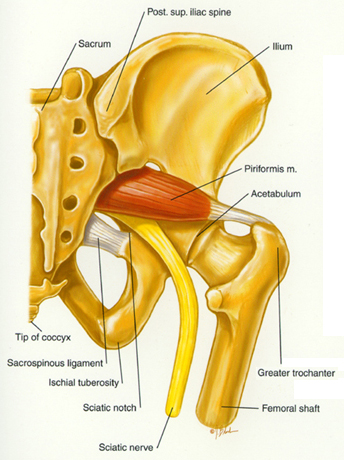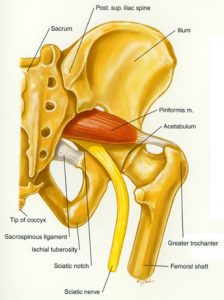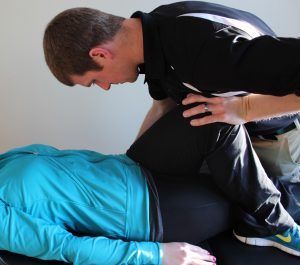Sciatica Treatments

Symptoms of Sciatica
Sciatica is a symptom consisting of radiating buttock and/or leg pain. These symptoms may range from feeling like a bad leg cramp to excruciating, shooting pain that makes standing or sitting nearly impossible. Sciatica can occur suddenly or it can develop gradually. It is also common to feel weakness, numbness, or a burning or tingling (“pins and needles”) sensation down the leg, possibly even in the toes. Less common symptoms might include the inability to bend the knee or move the foot and toes.
What causes sciatica?
 The symptoms of sciatica can be caused by several conditions. Each of these conditions involve irritation of the sciatic nerve. The sciatic nerve starts in the spine in low back and runs down the back of the leg. It divides into smaller nerves that travel down the calf to the bottom of the foot. The sciatic nerve can become irritated in several different locations along its tract.
The symptoms of sciatica can be caused by several conditions. Each of these conditions involve irritation of the sciatic nerve. The sciatic nerve starts in the spine in low back and runs down the back of the leg. It divides into smaller nerves that travel down the calf to the bottom of the foot. The sciatic nerve can become irritated in several different locations along its tract.
Conditions that cause sciatica:
Herniated disc- A bulging or herniated disc puts pressure on a nerve root, creating nerve irritation and pain. This is the most common cause of sciatica symptoms.
Spinal stenosis- This condition results from narrowing of the spinal canal which also puts pressure on the nerves.
Spondylolisthesis- This involves the movement of one vertebra so that it is anterior to the one below it. This movement narrows the opening through which the nerve exits the spinal canal.
Piriformis syndrome- The piriformis, a small muscle that lies deep in the buttocks, becomes tight or spasms. This puts pressure on and irritates the sciatic nerve.
How is sciatica diagnosed?
A complete medical history and physical exam allows the chiropractor to diagnose sciatica and determine its cause. The exam should include orthopedic and neurologic testing to determine the location and extent of the sciatic nerve irritation.
Other diagnostic tests might be performed to look for other causes of sciatic pain. Such testing might include:
- X-ray
- Magnetic resonance imaging (MRI) or computed tomography (CT) scan
- Nerve conduction velocity studies/electromyography
- Myelogram using dye injected between the vertebrae to determine if a vertebra or disc is causing the pain
However, most patients with sciatica can be treated without the need for further diagnostic imaging.
Our Integrated Approach to Treatment
The goal of treatment focuses on decreasing pain and improving mobility. Additionally, once pain has decreased the focus will shift toward restoring proper function so the condition does not reoccur. The techniques and treatments utilized by our chiropractors vary depending on the cause of your sciatica symptoms. A detailed evaluation helps classify your condition and identify the best treatment approach to quickly relieve your pain. Our chiropractor then prescribes specific exercises based on your exam findings to decrease the radiating pain into the leg.
If your symptoms result from a lumbar spine condition, treatment will focus on reducing irritation to the nerve root and improving joint and disc function in the low back. If your symptoms result from piriformis syndrome, treatment will focus on proper hip mobility and establishing a muscle balance between the gluteal muscles and the deep external hip rotator muscle group.
Our treatment options include multiple techniques to provide you with the best care available.
- McKenzie (MDT) therapy
- Graston Technique
- Active Release Technique (myofascial release)
- Exercise therapy (for strengthening core or glute muscles)
- Foam rolling stretches and exercises
Other Treatment Options
 In few cases, patients do not respond well to conservative care or pain is too severe to begin manual therapy treatments. In these situations, care will be coordinated with your medical doctor to achieve a positive outcome and reduce pain. Other treatment options for sciatica include the following.
In few cases, patients do not respond well to conservative care or pain is too severe to begin manual therapy treatments. In these situations, care will be coordinated with your medical doctor to achieve a positive outcome and reduce pain. Other treatment options for sciatica include the following.
- Prescription Medication — Pain medicines and anti-inflammatory drugs may help to relieve pain and stiffness, allowing for increased mobility and exercise. Muscle relaxants might be prescribed by a medical doctor to relieve the discomfort associated with muscle spasms. Depending on the level of pain, prescription pain medicines might be used in the initial period of treatment to allow for more effective conservative care results.
- Spinal injections — An injection of an anti-inflammatory medicine into the lower back might help reduce swelling and inflammation of the nerve roots, allowing for increased mobility, if conservative care methods are not yielding the expected results.
- Surgery — Surgery might be needed for people who do not respond to conservative treatment, who have progressing symptoms, and are experiencing severe pain.
 262-373-9168
262-373-9168



